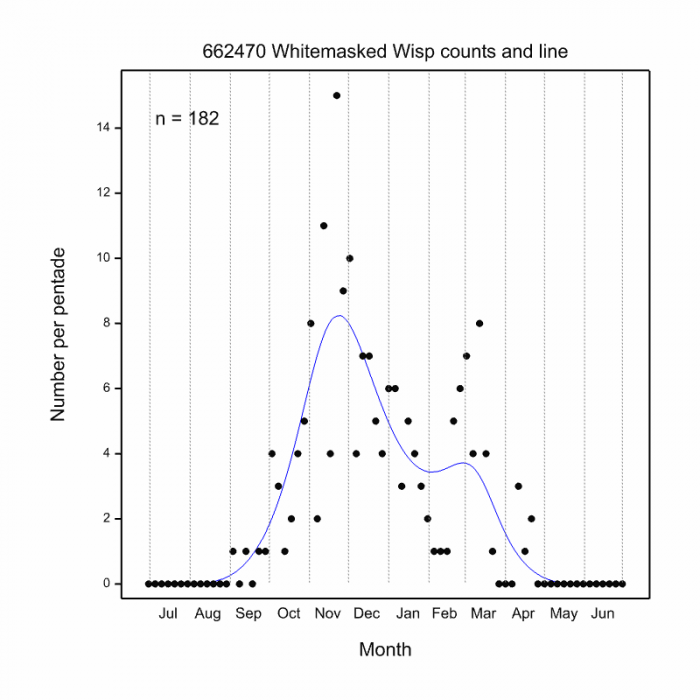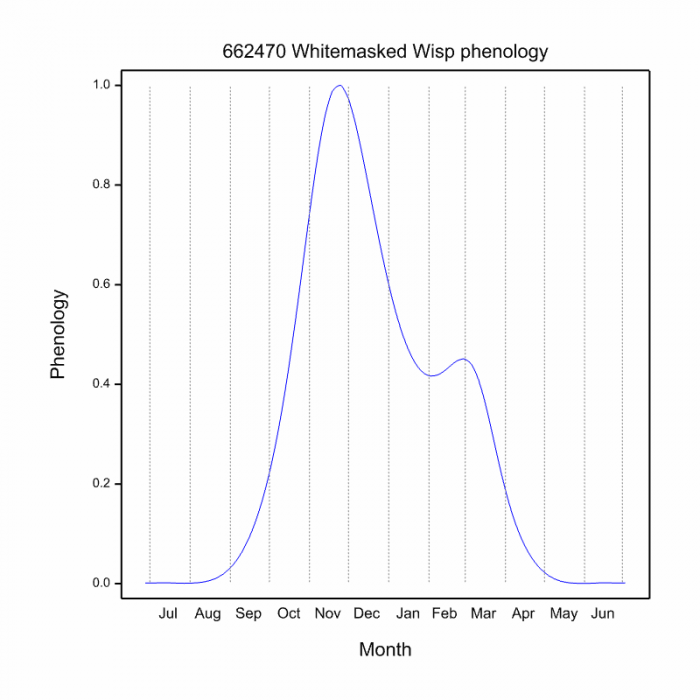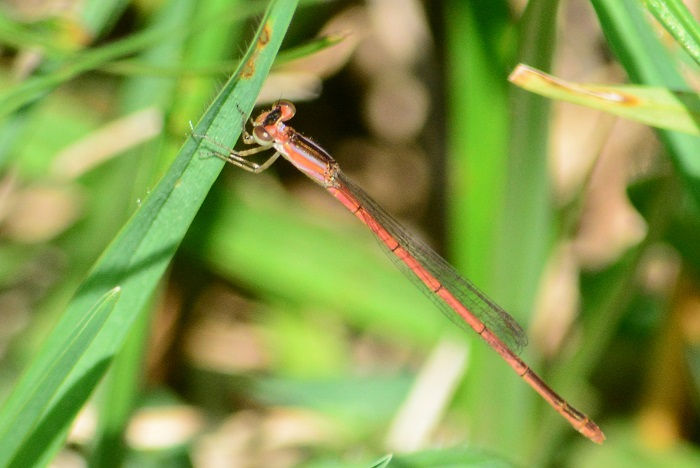Cover photo by John Wilkinson.
Find the White-masked Wisp in the FBIS database (Freshwater Biodiversity Information System) here.
Family Coenagrionidae
Identification

Kromme River, Eastern Cape
Photo by Gregg Darling
Very small size
Length up to 25mm; Wingspan attains 30mm.
There are two subspecies of the White-masked Wisp in southern Africa, Agriocnemis falcifera falcifera and Agriocnemis falcifera transvaalica.
When immature, White-masked Wisp males are initially all orange-red. Later stages are orange-red on the terminal segments of the abdomen only. When mature, only the terminal segments are orange-red. In old males the green colouration on the thorax and head turns pruinose white.
The forehead has a whitish band or ‘mask’ that runs from eye to eye and this is a diagnostic feature. The shape of the small green post-ocular spots are also diagnostic. They are tapered along the inner edge and connected across the back of the head in subspecies falcifera. In subspecies transvaalica the postocular spots are not connected.
Females are highly variable and range from all red or orange to green and black.
The White-masked Wisp is most similar to Agriocnemis gratiosa (Gracious Wisp). The White-masked Wisp can be told apart by its tapered and joined postocular spots and the white moustache stripe in the males. These two species are the largest Southern African wisps which helps to separate them from the other smaller species.
Click here for more details on identification.

iXopo district, KwaZulu-Natal
Photo by Ryan Tippett
Habitat
This tiny damselfly is found along the fringes of ponds, lakes, pools, and dams. The White-masked Wisp favours marshy sites with thick stands of grasses, sedges, and reeds. It can also be found on occasion along suitable, slow-moving sections of rivers.

Photo by Andries De Vries
Behaviour
The White-masked Wisp is inconspicuous due to its tiny size and its habit of sitting low down among the grass stems, where it is well hidden. It is often gregarious, and males and females occur in the same vicinity.
The White-masked Wisp is on the wing from September to April (See Phenology below).

iXopo district, KwaZulu-Natal
Photo by Ryan Tippett
Status and Conservation
The White-masked Wisp is locally common. It is listed as of Least Concern in the IUCN Red List of Threatened Species. The White Masked Wisp has adapted to the marshy fringes of dams and other man-made habitats.
Distribution
The White-masked Wisp is endemic to South Africa. The subspecies Agriocnemis falcifera falcifera occurs in a broad strip along the east coast from northern KwaZulu-Natal to the Western Cape. Agriocnemis falcifera transvaalica occurs inland in parts of Mpumalanga, Gauteng, and Limpopo.

iXopo district, KwaZulu-Natal
Photo by Ryan Tippett
Below is a map showing the distribution of records for White-masked Wisp in the OdonataMAP database as at February 2020.

Below is a map showing the distribution of records for White-masked Wisp in the OdonataMAP database as of December 2024.

The next map below is an imputed map, produced by an interpolation algorithm, which attempts to generate a full distribution map from the partial information in the map above. This map will be improved by the submission of records to the OdonataMAP section of the Virtual Museum.


Ultimately, we will produce a series of maps for all the odonata species in the region. The current algorithm is a new algorithm. The objective is mainly to produce “smoothed” maps that could go into a field guide for odonata. This basic version of the algorithm (as mapped above) does not make use of “explanatory variables” (e.g. altitude, terrain roughness, presence of freshwater — we will be producing maps that take these variables into account soon). Currently, it only makes use of the OdonataMAP records for the species being mapped, as well as all the other records of all other species. The basic maps are “optimistic” and will generally show ranges to be larger than what they probably are.
These maps use the data in the OdonataMAP section of the Virtual Museum, and also the database assembled by the previous JRS funded project, which was led by Professor Michael Samways and Dr KD Dijkstra.
Phenology



iXopo district, KwaZulu-Natal
Photo by Ryan Tippett
Further Resources
The use of photographs by Andries De Vries, Gregg Darling, and John Wilkinson is acknowledged. Other photographs by Ryan Tippett.
White-masked Wisp Agriocnemis falcifera Pinhey, 1959
Other common names: Witmaskersoetjie (Afrikaans)
Recommended citation format: Loftie-Eaton M; Navarro R; Tippett RM; Underhill L. 2025. White-masked Wisp Agriocnemis falcifera. Biodiversity and Development Institute. Available online at https://thebdi.org/2020/04/22/white-masked-wisp-agriocnemis-falcifera/
References: Tarboton, M; Tarboton, W. (2019). A Guide to the Dragonflies & Damselflies of South Africa. Struik Nature.
Samways, MJ. (2008). Dragonflies and Damselflies of South Africa. Pensoft
Samways, MJ. (2016). Manual of Freshwater Assessment for South Africa: Dragonfly Biotic Index. Suricata 2. South African National Biodiversity Institute, Pretoria

